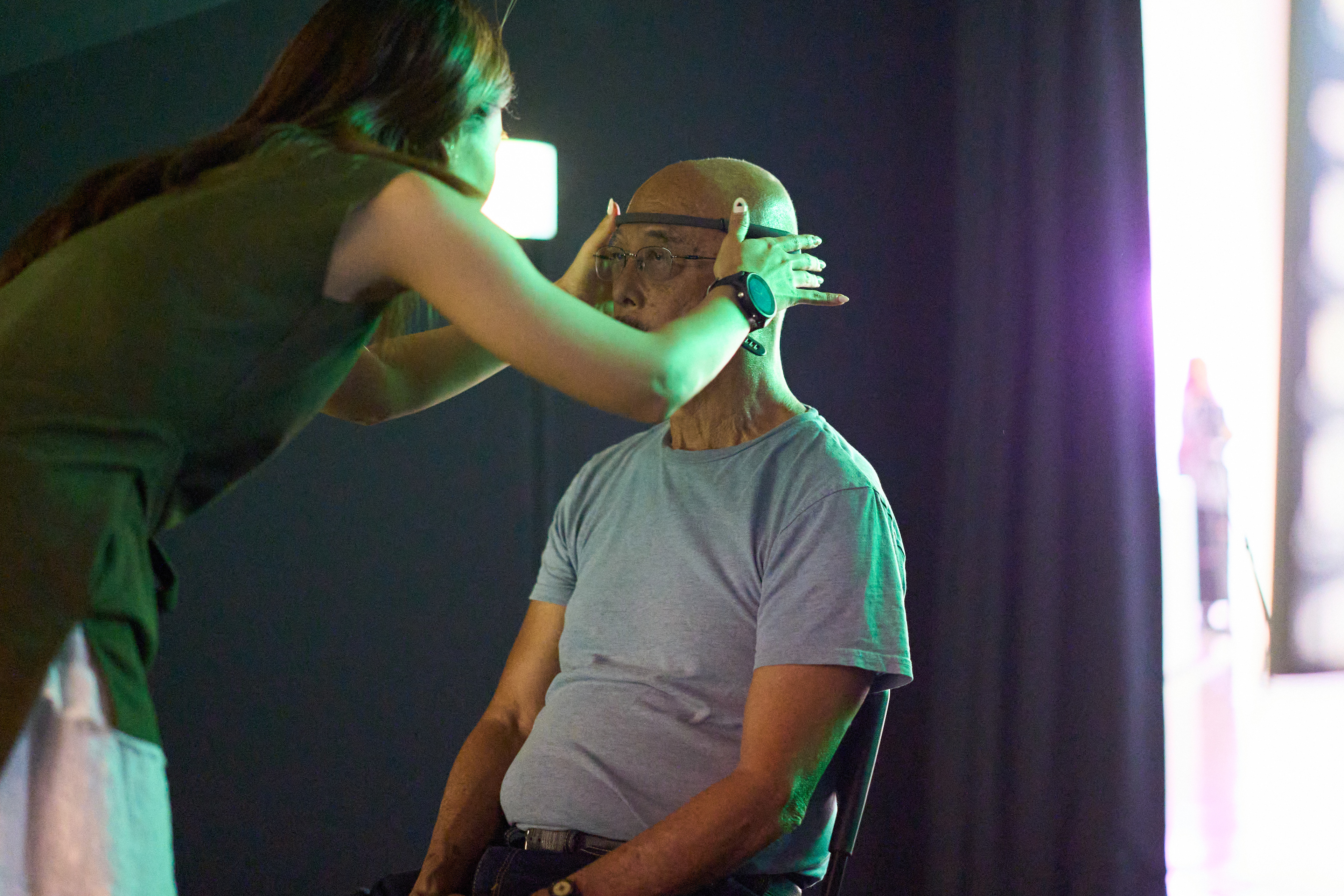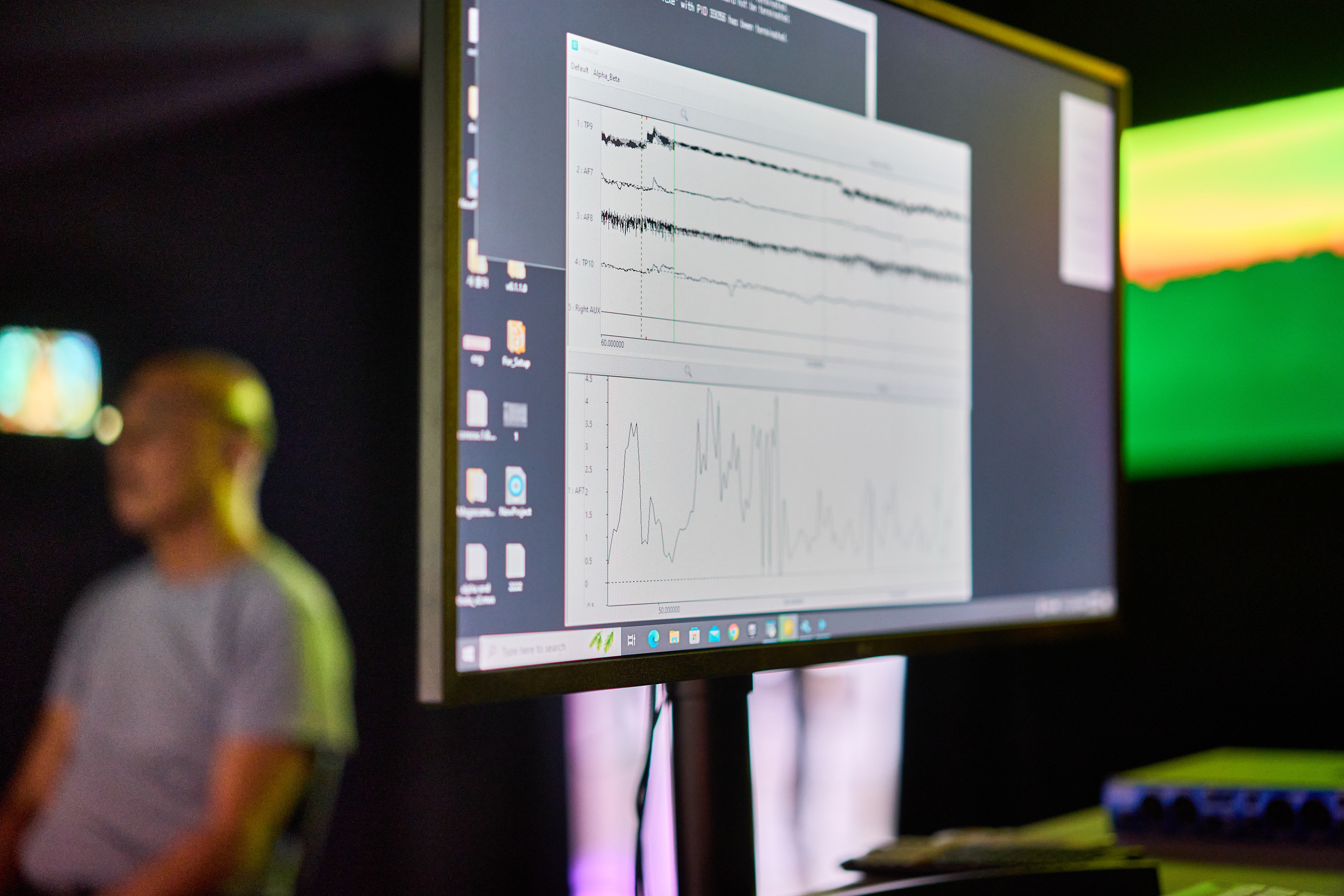Happy New Year - On Air Garden Series, 2024.
A single channel game engine video and sound, a projector,
EEG devices, resonance speakers and a system computer.
The On Air Garden Series is a project inspired by the Buddhist concepts of the ‘three poisons (三毒)’, which consist of greed(貪), anger(瞋), and foolishness(痴). It employs brainwave interactive technology to interrogate Eastern and Western utopian ideals, manifested through layers of Buddhist notions of reincarnation, traditional Korean Chaekgeori (traditional still-life painting), and Western cabinets of curiosities, all of which offer an aesthetic and philosophical worldview that spans reality and imagination.
On Air Garden Series examines the intersection of Nature, Humanity, and Technology, exploring how these three elements interact, intersect, and transform one another in our rapidly changing world. The title, “On Air,” alludes to everyday television and radio broadcasts, while also evoking invisible currents—be they air, streams, or waves—and aims to capture, both visually and aurally, the interplay of the visible and the invisible that underpins our reality.
Grounded in East Asian philosophical traditions, the series draws inspiration from Korean Chaekgeori and the Western Cabinet of Curiosities, weaving these motifs into a contemporary context that resonates with the cyclical worldview of Buddhist thought. Historically, Chaekgeori showcased objects of knowledge and curiosity through artful arrangement, much like the Western Cabinet of Curiosities collected and displayed rare or exotic artefacts. By bringing these two traditions together, the project highlights how both cultures have long endeavoured to contextualise hidden layers of human curiosity, collecting, and the quest for understanding.
In On Air Garden Series, these cross-cultural influences merge with BCI (Brain-Computer Interaction), interactive video and sound, and projection mapping, transforming concepts of interconnection and cyclical processes—drawn from East Asian art and Buddhist philosophy—into a living, participatory environment. Viewers do far more than simply observe; they actively participate and interact, experiencing the organic ecology born of the convergence of nature, technology, and humanity.
A defining feature of On Air Garden Series is the use of a “digital garden” as its stage—an adaptive space that integrates the multi-layered realities of the world into the symbolic notion of a ‘garden.’ Traditionally a site of repose and reflection, and of human–nature harmony, the garden here becomes a metaphorical environment that addresses urbanisation, technological advance, ecological disruption, and human alienation. Through real-time data flow, participant interaction, and evolving narratives, On Air Garden Series envisions a future landscape in which nature and humanity, the analogue and the digital, seamlessly coexist.
While posing social and philosophical questions, the project maintains an emphasis on aesthetic immersion to ensure that audiences feel invited rather than overburdened. The visuals on screen respond in real time to data inputs, visitors’ movements, and online engagement, offering a sense of dynamic artistic interaction infused with humanistic reflection on potential artificial utopias. Traditional elements—such as the Chaekgeori concept or echoes of Buddhist cyclical thought—are reshaped by digital imaging and paired with present-day urban motifs or technological artefacts, creating an ever-evolving “collection” reminiscent of a Cabinet of Curiosities.
Ultimately, On Air Garden Series invites viewers to contemplate utopia, tradition, and modernity within the overarching framework of a “garden.” Here, East meets West, the visible meets the invisible, and the old meets the new. By offering participants the chance to become ‘co-creators’ of the work—through interaction, choice, and reflection—the series encourages deeper inquiry into the complexities stemming from accelerating technologies, and how these forces may shape collective values, the environment, and the possibility of a more harmonious future.
"Happy New Year - On Air Garden Series" is the first version of the series, concretizing the concept of foolishness(痴). It is a cinematic interactive installation that utilizes a game engine to create a fictionalized landscape. Amidst the cheerfulness of celebrating the New Year around the world between December 31, 2023 and January 1, 2024, the piece reminds us of situations around the world that are suffering from war, disaster, and climate crisis.
Visitors enter this surreal landscape wearing a wireless EEG device. Once they reach a state of relaxation, a spectacular fireworks display takes place. The work reflects on the paradoxical situation in which the positively biased virtual worlds created by today's AI technologies can make us even more blind to the darker realities of our apathy. The fictionalized utopian images in the work are reminiscent of Chaekgeori(Korean traditional still-life painting that depicts books along with various other objects) and Western Cabinet of curiosities, connecting our world of war, disaster, death, and ruin to the Buddhist Wheel of Reincarnation, where heaven and hell, birth and death, coexist.
Visitors enter this surreal landscape wearing a wireless EEG device. Once they reach a state of relaxation, a spectacular fireworks display takes place. The work reflects on the paradoxical situation in which the positively biased virtual worlds created by today's AI technologies can make us even more blind to the darker realities of our apathy. The fictionalized utopian images in the work are reminiscent of Chaekgeori(Korean traditional still-life painting that depicts books along with various other objects) and Western Cabinet of curiosities, connecting our world of war, disaster, death, and ruin to the Buddhist Wheel of Reincarnation, where heaven and hell, birth and death, coexist.
Happy New Year - On Air Garden Series: A Neuro-Interactive System Workflow
"Happy New Year (2024)," part of the On Air Garden series, is a multi-agent BCI (Brain-Computer Interface) artwork that utilizes real-time EEG monitoring. The artwork records brain activity from two participants using wireless headbands equipped with sensors at the AF7 and AF8 positions, capturing brainwaves at a sampling rate of 256 times per second. The collected data is transmitted to a computer via Bluetooth and precisely synchronized using the Lab Streaming Layer (LSL).
This artwork employs hyperscanning technology to explore the interaction between the brainwaves of two participants. Hyperscanning is a technique that simultaneously records and analyzes neural activity from two or more brains, allowing researchers to study the communication and connection between brains. In 'Happy New Year,' hyperscanning enables the artwork to serve as a medium for interaction between the participants.
During the preprocessing stage, the OpenViBE software processes the brainwave signals. A Butterworth filter is applied to isolate alpha waves* and beta waves**. The software calculates the level of relaxation by evaluating the ratio of these two brainwaves of each participant. The processed data is then transmitted to Unreal Engine 5 using the OSC (Open Sound Control) protocol. This enables the creation of a reactive fireworks display and sound based on the participants' level of relaxation.


Brainwave interaction operating view.
